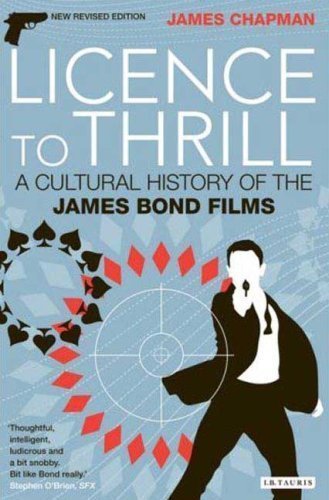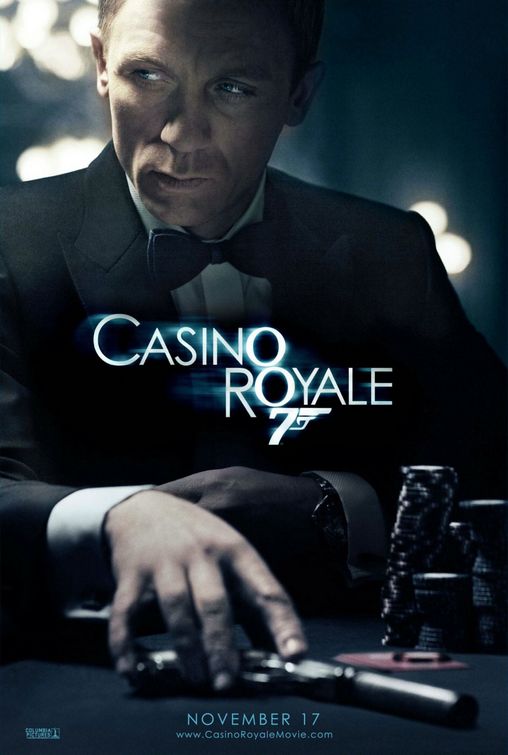Licence to Thrill. A Cultural History of the James Bond Films (second  revised edition), James Chapman, (2007) London & New York: I. B. Tauris, 336pp., ISBN: 978845115159 (pbk), $19.95/£12.99
revised edition), James Chapman, (2007) London & New York: I. B. Tauris, 336pp., ISBN: 978845115159 (pbk), $19.95/£12.99
The first edition of James Chapman’s book came out in 1999, when Pierce Brosnan’s incarnation of the character had managed to resurrect Bond as box-office phenomenon after the lacklustre films of Timothy Dalton and a six-year long hiatus. This second edition was revised in the light of yet another successful resurrection of Bond, the back to basics Casino Royale (2006) and the rugged appearance of character actor Daniel Craig as 007. Errata aside, chapters 2-7 (from Dr. No to Licence to Kill) have been left unchanged while the introduction (’Taking James Bond Seriously’) and chapter 1 (previously ’Bond and Beyond: The James Bond Films and Genre’, now ’The Contexts of James Bond’) are completely rewritten.
Chapter 8 (previously ’For England’, now ’Millennial Bond’) is also rewritten and expanded to include The World Is Not Enough (1999) and Die Another Day (2002), and a ninth chapter on Casino Royale is added. Finally, the postscript has been deleted; the material now included in the rewritten chapters. This new edition is almost 20 pages shorter than the original, partly by excluding the many stills in the original (perhaps to cut costs) but also due to the makeover of chapter 1, trimming down the text from 45 to 27 pages.
Left in chapter 1 is the prehistory of British spy and action heroes (’Bulldog’ Drummond, Dick Barton et. al.), Chapman’s appraisal of the 1954 CBS TV version of Casino Royale and the prospect of an alternate Bond history in Ian Fleming’s outline for an American TV series. As Chapman notes, the ’Britishness’ did not become a feature of the Bond phenomenon until much later. However, I still miss is the context of the post-war dystopian science fiction genre themes in literature and film (corporate world domination, the bomb, the death of ideologies, new totalitarianism etc.) that the Bond movies take on with a high camp attitude that sometimes touches on black parody in the vein of Stanley Kubrick’s Dr. Strangelove (1963).

The latest decline of Bond started in 1999, at the time of the publishing of the first edition, while the films soared at the box office. Rather, it was the critics and the Bond fan culture – vital as keepers of the mythology and of the continuing popularity of the series – that responded with animosity. Paradoxically, Die Another Day became the most successful of the Brosnan titles while being scolded in the press and on the Internet as bloated by CGI effects and rehashing old material. Ignoring capitalist logic, the producers took note of the critical response and ’rebooted’ (their word according to Chapman) the series by going back to the novel in which Fleming originally introduced his hero: Casino Royale.
Chapman claims the ’reboot’ is not another resurrection but a ’Revisionist Bond’ – the title of the last chapter. The first step is a “modernisation… stripping away the Cold War trappings and updating [Fleming’s story] to an era of global terrorism and financial intrigue”, but, as he notes, this “updating the source material” is “standard practice for the Bond series”. He then goes on to appreciate the ’Freudian subtext’, which he considers to be a contribution from script doctor Paul Haggis, and “its return to the tradition of real stunts and action sequences”. Perhaps this is enough to qualify the film as “revisionist”. The most radical move away from Cold Warrior Bond I think is in Quantum of Solace (2008) – the sequel (so far the only sequel in the history of the series) to Casino Royale .
The new Spectre-like organization, Quantum, is a dark representative of globalized capitalism, buying and selling just about everything, including governments and natural resources like water. When fighting the organization, Bond has no other choice but to act as a rogue agent. M explains that it might be immoral to deal with Quantum – as the British government also has done – but whom else to deal with? This suggests the end of Bond as loyal ’keeper of the faith’ since there is none to be loyal to anymore. Whatever next, Bond joining Greenpeace?
Naturally, Chapman’s book, published in January 2007, couldn’t foresee this new development. It is only vaguely hinted at in Casino Royale, but it is certainly a challenge that Quantum of Solace has set up for the series to address. Knowing Chapman’s work, I am sure he will discuss this in the same easygoing mix of academia and fan enthusiasm when writing the next revised edition of Licence to Thrill. The format is appealing, although I think he could easily add a hundred pages or so in order to plunge deeper into the cultural history of the now 22 Eon productions (and a few runaway Bond films). I am looking forward to the third edition of the book with the same high expectations as the next Bond film at the cinemas.
© Michael Tapper, 2009. Film International, vol. 7, no. 3, 2009, pp.73—74.